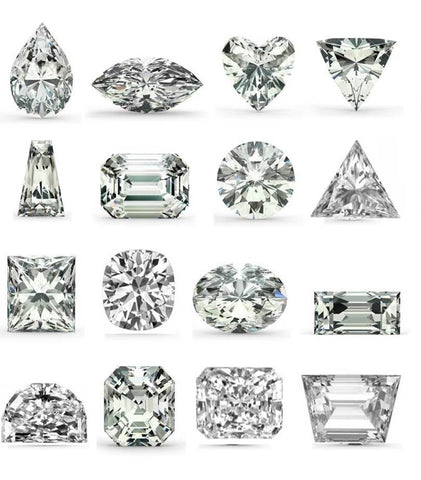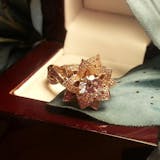Cubic Zirconia, commonly known in jewelry circles as “CZ”, has been the most popular more-affordable alternative to natural diamonds since the stone was first produced for commercial use in jewelry, industrial machinery, lasers and other applications almost 4 decades ago (1976). The highest-quality CZ stones are flawless, with brilliant sparkle, tremendous clarity, and radiant fire, good durability and hardness, and are visually indistinguishable from natural diamonds to the naked eye.
But is cubic zirconia actually in fact a diamond?
While cubic zirconia exists in nature (see Is Cubic Zirconia a mineral?), the mineral is rare enough that the CZ used in most commercially produced jewelry manufactured over the last 4 decades is of a man-made origin. If you want to get the scientific skinny, cubic zirconia is actually the cubic crystalline form of a physical compound made up of the elements Zirconium and Oxygen (ZrO2 to be precise) called Zirconium Dioxide.
ASIDE: No wonder we adopted name ‘Cubic Zirconia’, right? It’s got a pretty sexy sound, while ‘Zirconium Dioxide’ honestly sounds like a laundry detergent.
Natural diamonds are found in nature, and as such cannot be considered the same as cubic zirconia stones, the majority of which used in commercial jewelry are man-made.
There’s the short answer to your burning question about whether cubic zirconia are diamonds.
While the stone looks like a diamond and possesses many diamond-like qualities— to the degree that even jewelers with decades of experience cannot tell the difference between a high-quality CZ and a perfect diamond by simply comparing the two side by side with the naked eye alone— Cubic Zirconia is not a diamond.
However, the difference in cost between diamonds and diamond simulants such as cubic zirconia—and others that are somewhat deceptively sold under ‘diamond’ names—can be thousands to tens of thousands of dollars. That’s why perhaps a more important question to answer than if cubic zirconia is a diamond, is whether that DIAMOND you are thinking about purchasing is actually a real diamond?
Before you shake your head or walk away confused from this webpage, bear with me a moment…OK? The truth is: in order to FULLY answer your question if cubic zirconia is a diamond, really you first have to decide in your own mind what a ‘diamond’ is to you.
When you think of diamonds, you probably think of a handful of extremely rare and valuable gemstones mined with great cost and difficulty from deep in the earth, a finite resource that is dwindling in supply…am I right? What if I told you that a large percentage of diamonds sold as ‘diamonds’ today were in fact grown in a lab, created by combining various physical elements into compounds that mimic natural diamonds— very much like cubic zirconia are also manufactured?
What if continued down the rabbit hole and I told you that there was absolutely no limit on the number of these kinds of ‘diamonds’ that could be created in the lab?
That’s right! Those lab-grown diamonds are sold to unsuspecting customers at prices that are just a bit cheaper than natural diamonds mined with sweat and sacrifice (and innocent blood, too, but that’s another story) from the earth…but prices still high enough to be damned difficult to justify in this man’s opinion—an opinion shared by increasing numbers of savvy consumers who know what their money is worth—for a product that is limitless in supply, as opposed to more rare natural diamonds.
And these folks even have the nerve to give their lab-grown ‘diamonds’ an appraisal, and a report, and a certification just like real diamonds mined from the earth and limited in supply…as if they didn’t just whip up a batch in the back-room with a chemistry set.
So, maybe you won’t think it’s such a silly question anymore to ask “Is that DIAMOND really a diamond?”
Listen, natural diamonds have their place. Historically, there is a great tradition that links a diamond in the minds of women—and men—as a rock that symbolizes much more than just geology. And natural diamonds do have some intrinsic value, because they have uses in industry beyond just looking pretty, and a scarcity upon which much of the value of any natural resource is based.
Though, frankly, they’re not as rare as the diamond mining cartels would have you believe— they own full warehouses bursting with them, stones they intentionally keep off the market to inflate prices— natural diamonds still are a finite resource.
If the tradition concerns you and money is no object, by all means…purchase a diamond. We think the money can be much better spent in other ways, but that’s just our opinion and you came here for hard facts about cubic zirconia. After all, some people want to light cigars with $100 bills, too.
However, I want you to think very hard before you pay anything more than $200 USD for any ordinary-size and non-custom-cut substitute gemstone made in a lab, no matter what they call it or how many reports, certifications, or appraisals the faux diamond may receive as part of the proof provided to entice you to pay a bunch of money for something God didn’t have a hand in creating.
$5000 for a lab-grown diamond loose stone? It boggles the mind anyone would pay such high prices for a lab-grown diamond when natural diamonds of good size can be obtained for not much more, and high-quality 5A cubic zirconia for 1/100 or less of the cost.
I hope you’ve learned a few things in this post. No, cubic zirconia is not a diamond. But for that matter, a large percentage of ‘diamonds’ sold today aren’t diamonds either, not by this man’s definition.
What do you think?
Let me know if you have any questions in the comments below/
Mr. Cubic Zirconia
CubicZirconia.com
P.S. Want to know more of the nitty-gritty about the differences between Diamonds vs Cubic Zirconia? We’ve got an ever-growing resource, with case studies and more, ready for your reading pleasure. Take a few minutes and read up, especially if you’re shopping for an engagement ring…after all, if everything goes right, you’ll only be buying ONE. And if what I’m telling you is true—and it is, and our company will prove it to you— you don’t need a diamond engagement ring, when you can get a cubic zirconia replica engagement ring with a lifetime guarantee, and have no one know the difference while you take the difference in price and spend for fun or invest for the future in ways that will satisfy you much more than a rock.












1 thought on “Is Cubic Zirconia A Diamond?”
zircon vs cubic zircon
Great details.
thanks for sharing this really the contant is amazing
informative,interesting , motivative also which was i am looking for . please keep updating step by step
zircon vs cubic zirconia